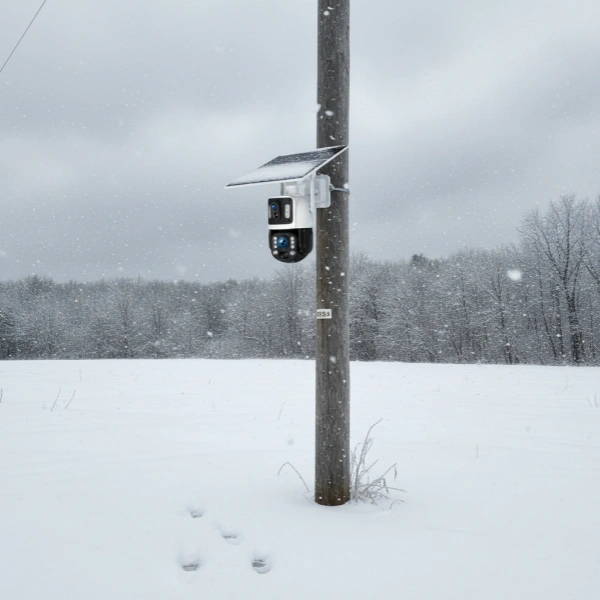Securing Natural Beauty: The Definitive Guide to Solar Cameras for Tourist Attractions
Protecting our planet’s most beautiful natural landscapes and tourist attractions presents a unique security challenge. How do you ensure visitor safety, deter vandalism, and monitor remote areas without scarring the scenery with intrusive infrastructure and cabling? For park managers, resort owners, and conservation authorities, this is a constant operational headache. The cost and logistical nightmare of trenching for power and data lines in a national park or along a scenic coastline are often prohibitive.
Traditional security systems are simply not designed for these environments. They rely on a constant power grid and wired connectivity, which are absent in the very places that need monitoring most: remote trailheads, secluded viewpoints, wildlife habitats, and expansive parking areas. This creates security blind spots, leaving these locations vulnerable to theft, illegal activity, and safety incidents, while also making emergency response difficult.
As an engineer with over a decade of experience designing off-grid security solutions, I’ve seen these challenges firsthand. The answer lies in a technology that works in harmony with nature: the solar-powered security camera. These systems offer a robust, eco-friendly, and cost-effective way to bring surveillance to the great outdoors, seamlessly integrating security with scenery.
How Solar Security Cameras Provide Power and Protection, Off-Grid
The concept behind a solar security camera is elegantly simple yet technologically sophisticated. At its core, the system is a self-sufficient ecosystem designed for long-term, unattended operation in any location with sunlight. It’s a perfect solution for businesses like yours, whether you’re a brand owner, installer, or a 4G operator looking to expand service offerings.
Here’s a breakdown of the core components and how they work together:
- High-Efficiency Solar Panel: This is the engine of the system. Modern monocrystalline solar panels capture solar energy and convert it into DC electrical power, even on overcast days. The key is sizing the panel correctly based on the camera’s power consumption and the location’s average sunlight.
- Long-Life Battery Pack: The captured energy is stored in a high-capacity lithium-ion battery. This is where the quality of the Battery Management System (BMS) becomes critical. A robust BMS is the brain of the battery, protecting it from overcharging, over-discharging, and extreme temperatures, ensuring years of reliable service.
- Low-Power Camera Module: The camera itself is engineered for ultra-low power consumption. It remains in a standby state, drawing minimal energy, until triggered by a motion event. This efficiency is crucial for surviving long periods without sun.
- 4G/Wi-Fi Connectivity: For truly remote locations without any existing network, a 4G LTE module provides a direct connection to the cloud. A user simply inserts a data SIM card, and the camera is instantly online. In areas with an available signal, Wi-Fi models offer a more traditional connection.
This integrated design eliminates the need for any external wiring, allowing for rapid deployment anywhere. You can mount a camera on a pole, a tree, or a small structure in a matter of hours, not weeks, providing immediate security without disturbing the natural environment.
Blending In: The Art of Discreet Surveillance
A primary concern for any scenic attraction is preserving the aesthetic experience for visitors. A bulky, obvious security camera can detract from the feeling of being in nature. This is where design and customization, a core strength of a dedicated factory like UBOXCAM, become paramount. It’s not just about security; it’s about security that respects the environment.
As designers, we focus on several key principles for aesthetic integration:
- Camouflage and Custom Finishes: Standard white or black cameras stick out against a backdrop of trees and rock. We offer custom color-matching and matte finishes (e.g., forest green, bark brown, stone gray) that help the camera housing blend seamlessly into its surroundings.
- Compact and Integrated Form Factors: The goal is to minimize the visual footprint. Our designs often integrate the camera, solar panel, and battery into a single, sleek unit. This avoids a cluttered look and simplifies installation.
- Strategic Mounting Solutions: Beyond standard pole mounts, we can design brackets for mounting on trees (using non-damaging straps) or uneven rock surfaces. The placement itself is part of the art—positioning the camera to be effective yet unobtrusive.
Core Technology Comparison for Tourist Site Security
Choosing the right camera involves understanding the key technologies that ensure reliability in challenging outdoor settings. For a wholesaler, distributor, or installer, knowing these details helps you guide your clients to the best solution, building trust and demonstrating expertise.
| Technology Feature | Why It’s Critical for Tourist Sites | The UBOXCAM Engineering Advantage |
|---|---|---|
| Advanced BMS (Battery Management System) | Tourist sites face unpredictable weather. The BMS must maximize battery life and ensure the camera works through consecutive cloudy or rainy days. | Our multi-layered BMS provides precise protection against overcharge, over-discharge, high temperatures, and short circuits, guaranteeing 365 days of operation. |
| Connectivity (4G vs. Wi-Fi) | Most scenic areas lack Wi-Fi. 4G LTE is essential for real-time alerts and remote viewing from park headquarters or a mobile device. See our full 4G vs WiFi comparison. | We offer optimized 4G modules with wide band support for global carriers and robust antenna design for superior signal reception in remote areas. |
| Smart Dual-Light Night Vision | Standard IR provides black-and-white images. For identifying details like clothing color or vehicle type at night, color vision is superior and less disruptive to wildlife. | Our Smart Dual-Light system uses discreet IR by default. When a person is detected, it activates a low-lumen white light to capture full-color video, acting as a gentle deterrent without causing light pollution. |
| PIR + AI Humanoid Detection | Natural environments are full of false triggers (swaying branches, animals). Accurate alerts are vital to avoid “alarm fatigue” for security staff. | We combine a passive infrared (PIR) sensor to detect body heat with an AI algorithm that analyzes the shape to confirm it’s a person, reducing false alarms by over 95%. |
Case Study: Securing a Remote Coastal Viewpoint
- Problem: A popular but isolated coastal viewpoint was experiencing issues with after-hours vandalism and illegal beach parties, which damaged sensitive dune ecosystems. The nearest power source was over a mile away, and cellular service was spotty. Responding to incidents was slow and often too late.
- Solution: Our team was approached to provide a solution. We deployed two UBOXCAM 4G Solar PTZ Cameras. One was installed on a high pole overlooking the parking area, and the other was discreetly mounted on a utility structure overlooking the beach access path. The cameras were equipped with high-gain antennas to ensure a stable 4G connection. We configured smart detection zones to ignore the ocean waves but trigger alerts for human activity in restricted areas after closing time.
- Result: The impact was immediate and quantifiable. Within the first two months, real-time alerts allowed local authorities to prevent three large gatherings before they escalated, significantly reducing environmental damage. Incidents of vandalism dropped by 85%. The high-resolution video evidence was used to identify and fine individuals for illegal dumping, creating a powerful deterrent. The entire system has operated with 99.7% uptime, proving its reliability in a harsh, salty-air environment.
Troubleshooting & FAQ for Outdoor Deployments
Even the best systems can face challenges in the wild. Here are solutions to common issues encountered when deploying cameras in natural settings, demonstrating the practical experience baked into our products.
- Q: What happens if an animal damages the camera or solar panel?
- A: This is a valid concern in wildlife areas. We recommend mounting cameras at a height of at least 10-12 feet (3-4 meters). Furthermore, our cameras are built with durable, industrial-grade metal housings (not flimsy plastic) and reinforced mounting brackets to withstand physical impact.
- Q: How do the cameras handle extreme weather like snow, heavy rain, or high heat?
- A: All our wireless outdoor security cameras are rated IP66 or higher, meaning they are fully protected against dust and powerful jets of water. For snow, the angled placement of the solar panel helps it shed snow naturally. Our wide-temperature batteries and BMS are designed to operate reliably in climates ranging from -20°C to 60°C (-4°F to 140°F).
- Q: Will the camera’s lights disturb nocturnal wildlife?
- A: This is why our Smart Dual-Light technology is so important. In its default state, the camera uses infrared light, which is invisible to most animals and the human eye. The low-level white light only activates for a short duration when a human threat is detected, minimizing disturbance to the natural nighttime environment.
Your Checklist for Selecting a Solar Camera for a Tourist Attraction
For project managers and installers, choosing the right product is key to a successful deployment. Use this checklist to evaluate potential solutions and ensure they meet the demands of the environment.
- [ ] Sufficient Power Autonomy: Does the supplier specify how many days the camera can run without any sun? Look for a minimum of 3-5 days to ensure year-round reliability.
- [ ] Industrial-Grade Build Quality: Is the housing made of metal? Is it at least IP66 waterproof? This is non-negotiable for outdoor use.
- [ ] Accurate Detection Technology: Does it offer both PIR and AI-powered human detection to minimize false alarms from animals and nature?
- [ ] Global 4G Band Support: If using 4G, does the camera support the frequency bands of the local carriers in your country (e.g., USA, UK, Germany)?
- [ ] Customization Capability: Can the manufacturer provide custom colors or mounting solutions to help the camera blend in? This is a key benefit of working directly with a design factory.
- [ ] Proven Track Record: Ask for case studies or references for similar deployments in outdoor, off-grid environments. Experience matters.
Investing in solar security cameras is more than just a security upgrade; it’s a commitment to protecting visitors and natural resources in a smart, sustainable way. It enhances the reputation of your attraction as a safe and well-managed destination.
Are you ready to secure your scenic location without compromising its beauty? As a factory with deep engineering expertise, we can help you design a solution that fits your landscape and your budget. Contact our team today to get a customized quote and learn how our solar security cameras can provide peace of mind, powered by the sun.

